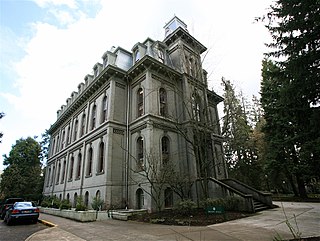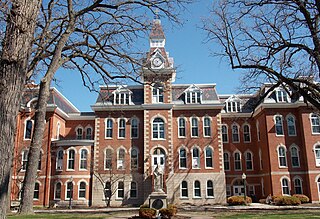
Marycrest College Historic District is located on a bluff overlooking the West End of Davenport, Iowa, United States. The district encompasses the campus of Marycrest College, which was a small, private collegiate institution. The school became Teikyo Marycrest University and finally Marycrest International University after affiliating with a private educational consortium during the 1990s. The school closed in 2002 because of financial shortcomings. The campus has been listed on the Davenport Register of Historic Properties and on the National Register of Historic Places since 2004. At the time of its nomination, the historic district consisted of 13 resources, including six contributing buildings and five non-contributing buildings. Two of the buildings were already individually listed on the National Register.

The Oregon State Capitol is the building housing the state legislature and the offices of the governor, secretary of state, and treasurer of the U.S. state of Oregon. It is located in the state capital, Salem. Constructed from 1936 to 1938 and expanded in 1977, the current building is the third to house the Oregon state government in Salem. The first two capitols in Salem were destroyed by fire, one in 1855 and the other in 1935.

Connecticut Hall is a Georgian building on the Old Campus of Yale University. Completed in 1752, it was originally a student dormitory, a function it retained for 200 years. Part of the first floor became home to the Yale College Dean's Office after 1905, and the full building was converted to departmental offices in the mid-twentieth century. It is currently used by the Department of Philosophy, and its third story contains a room for meetings of the Yale Faculty of Arts & Sciences, the academic faculty of Yale College and the Graduate School.

The Ogle County Courthouse is a National Register of Historic Places listing in the Ogle County, Illinois, county seat of Oregon. The building stands on a public square in the city's downtown commercial district. The current structure was completed in 1891 and was preceded by two other buildings, one of which was destroyed by a group of outlaws. Following the destruction of the courthouse, the county was without a judicial building for a period during the 1840s. The Ogle County Courthouse was designed by Chicago architect George O. Garnsey in the Romanesque Revival style of architecture. The ridged roof is dominated by its wooden cupola which stands out at a distance.

The Oregon Institute was an American school located in the Willamette Valley of the Oregon Country during the 19th century. Begun in 1842, it was the first school built for European Americans west of Missouri. Founded by members of the Methodist Mission, it was located in what is now Salem, Oregon. The school began as a pre-college institution, but by 1853 was developed as Willamette University. The school's three-story building was a prominent feature in the early days of Oregon; it served as a meeting place for the Oregon Territorial Legislature when it first moved to Salem.

The Mark O. Hatfield Library is the main library at Willamette University in Salem, Oregon, United States. Opened in 1986, it is a member of the Orbis Cascade Alliance along with several library lending networks, and is a designated Federal depository library. Willamette's original library was established in 1844, two years after the school was founded. The library was housed in Waller Hall before moving to its own building in 1938.

Gatke Hall is the second-oldest building at Willamette University in Salem, Oregon, United States. A two-story structure, it was originally built in downtown Salem in 1903 across the street from the Marion County Courthouse and served as a post office. The Beaux Arts styled building was moved to the university in 1938 and first served as the home to the law school.

Eaton Hall is an academic building on the campus of Willamette University in Salem, Oregon, United States. Completed in 1909, the four-story brick and stone hall is the fourth oldest building on the campus of the school after Waller Hall (1867), Gatke Hall (1903), and the Art Building (1907). Eaton is a mix of architectural styles and houses the humanities departments of the liberal arts college.

University Hall is the first and oldest building on the campus of Brown University in Providence, Rhode Island. Built in 1770, the building is one of only seven extant college buildings built prior to the American Revolution. According to architectural historian Bryant F. Tolles Jr., the structure is "one of the genuine icons of early American collegiate architecture."

Portland City Hall is the headquarters of city government of Portland, Oregon, United States. The four-story Italian Renaissance-style building houses the offices of the City Council, which consists of the mayor and four commissioners, and several other offices. City Hall is also home to the City Council chambers, located in the rotunda on the east side of the structure. Completed in 1895, the building was added to the National Register of Historic Places on November 21, 1974. City Hall has gone through several renovations, with the most recent overhaul gutting the interior to upgrade it to modern seismic and safety standards. The original was built for $600,000, while the 1996 to 1998 renovation cost $29 million.

Deady and Villard Halls, University of Oregon are historic academic buildings on the campus the University of Oregon in Eugene, Oregon. Built in 1876 and 1886 respectively, they are among the oldest surviving academic buildings on the west coast of the United States, and are noted for their Second Empire architecture. They were designated a National Historic Landmarks as a pair in 1977.

The Oregon Civic Justice Center is a three-story former library building on the campus of Willamette University in downtown Salem, Oregon, United States. Built in 1912 as a Carnegie library for the city of Salem, the building now houses several programs of Willamette University College of Law. Prior to the law school's moving into the facility in 2008, the building was used by the adjacent Young Women's Christian Association (YWCA) from 1971 to 2006.

Minthorn Hall is an academic building on the campus of George Fox University in Newberg, Oregon, United States. Built in 1887, the hall was moved ten blocks to its current location in 1892. The three-story frame building is the oldest building on the campus of the school, and was the first building of the Quaker school. Future President Herbert Hoover may have briefly lived in the structure prior to its conversion to a school building. The hall was added to the National Register of Historic Places on June 13, 1997.

The Art Building is an academic hall at Willamette University in Salem, Oregon, United States. Built in 1905 for the Willamette University College of Medicine, it is the third oldest building on campus after Waller Hall and Gatke Hall. The Beaux-Arts style red-brick building stands three stories tall and contains 14,000 square feet (1,300 m2) of space.

Lausanne Hall is a college residence hall at Willamette University in Salem, Oregon, United States. Built in 1920, the red-brick and stone-accented structure stands three stories tall along Winter Street on the western edge of the campus that was originally a residence for women only. The late Gothic Revival style building replaced a home that had also been used as a dormitory. This structure was moved to campus and originally was named as the Women's College before assuming the name of Lausanne.

Waldschmidt Hall is an academic building at the University of Portland in Portland, Oregon, United States. Constructed in 1891 as West Hall, the building was originally part of the now defunct Portland University located in North Portland overlooking the Willamette River. The Romanesque style structure built of brick and stone stands five stories tall. The hall was added to the National Register of Historic Places in 1977 and renovated in 1992, the same year it took the current name. Waldschmidt, the oldest building on campus, now houses the school's administration offices and some classrooms.

Ambrose Hall, located in Davenport, Iowa, United States, is the first building constructed on the campus of St. Ambrose University. It was listed on the National Register of Historic Places in 1977.

Ford Hall is a four-story academic hall at Willamette University in Salem in the U.S. state of Oregon. Completed in 2009, the building houses classrooms, offices, and laboratories from several disciplines of the school's College of Liberal Arts. The 42,000-square-foot (3,900 m2) structure cost $16 million and earned Leadership in Energy and Environmental Design (LEED) Gold certification upon completion for environmentally friendly features and construction. Ford Hall is named in honor of Hallie Ford, who contributed $8 million towards construction of the building.

The Bacon Academy, nicknamed Old Bacon Academy, was the original Bacon Academy. The Old Bacon Academy was built in 1803 and is located at 84 Main Street, Colchester, Connecticut. The main structure is a 70 feet (21 m) long by 34 feet (10 m) wide three-story Flemish bond brick structure with Federal style details. Noted for its plain, utilitarian floor plan consisting of two rooms off a central hall and stairway, the inside has seen some renovations throughout its history. The Day Hall, a contributing property purchased by the Bacon Academy trustees in 1929, is a church hall that was used for the high school until 1962.

College Hall is the central building of the campus of the Vermont College of Fine Arts in Montpelier, U.S. state of Vermont. Located prominently on Ridge Street atop Seminary Hill, this 1872 Second Empire building has been a major visual and architectural landmark in the city since its construction. It was listed on the National Register of Historic Places for its architectural significance in 1975.































